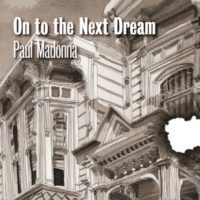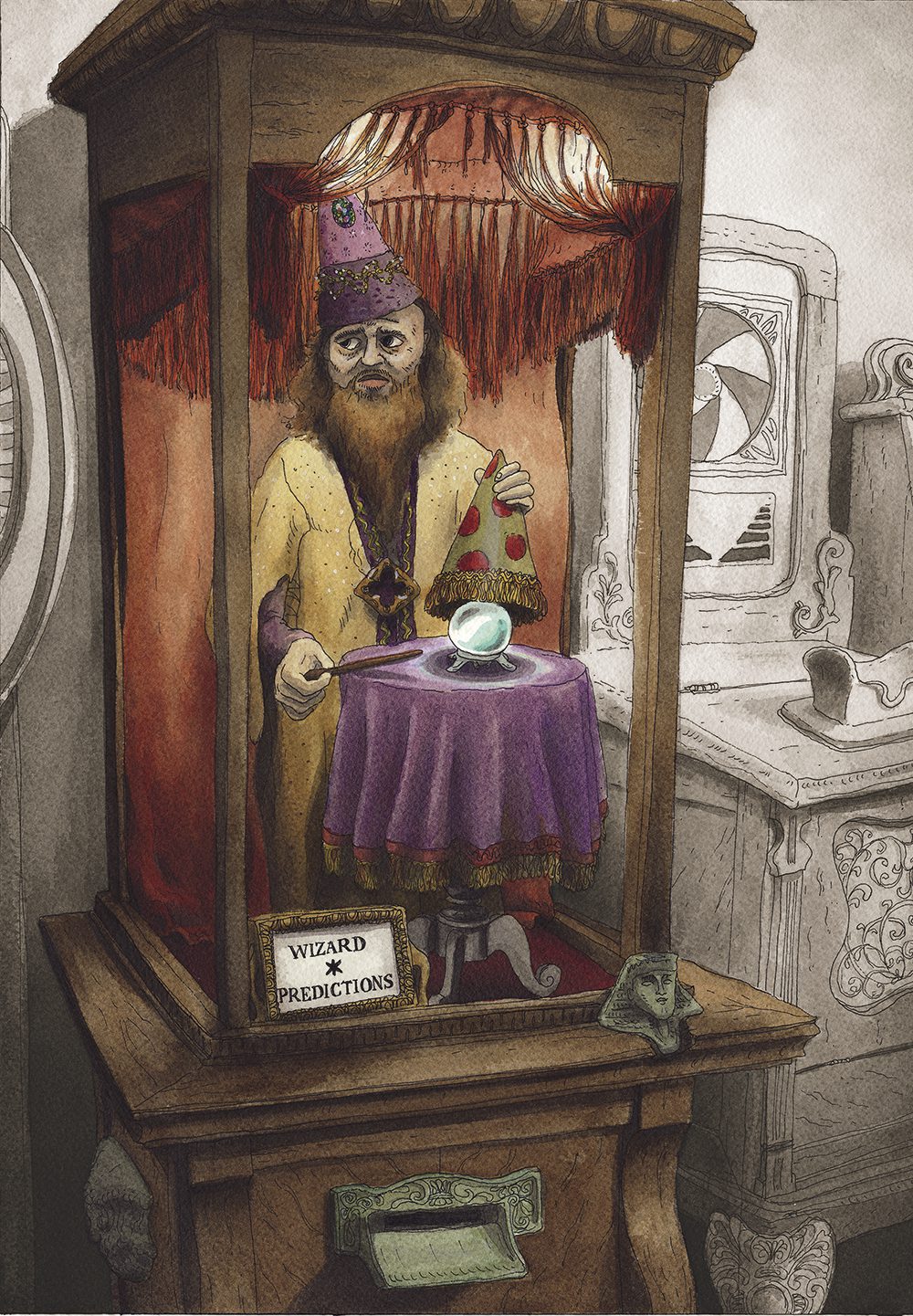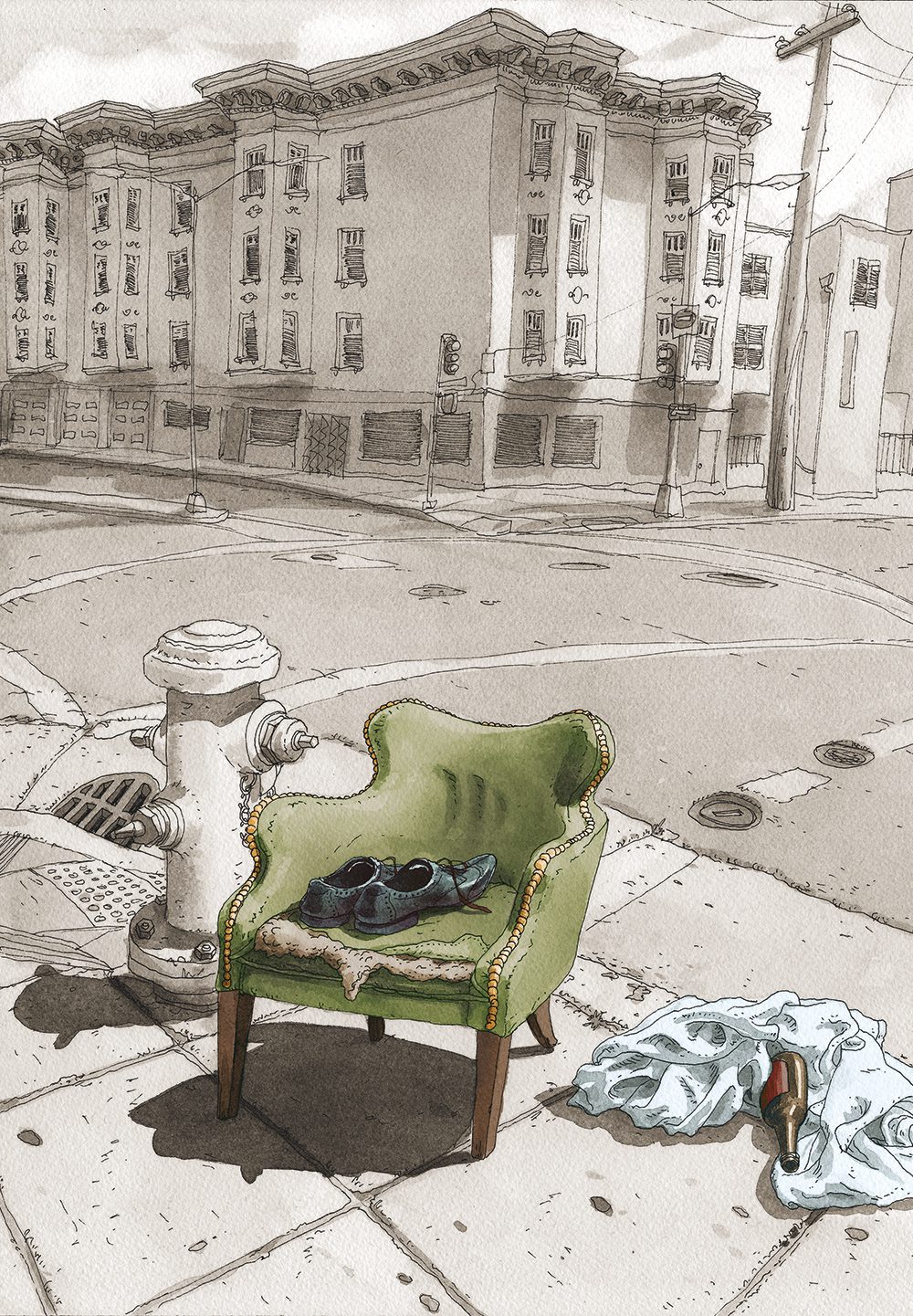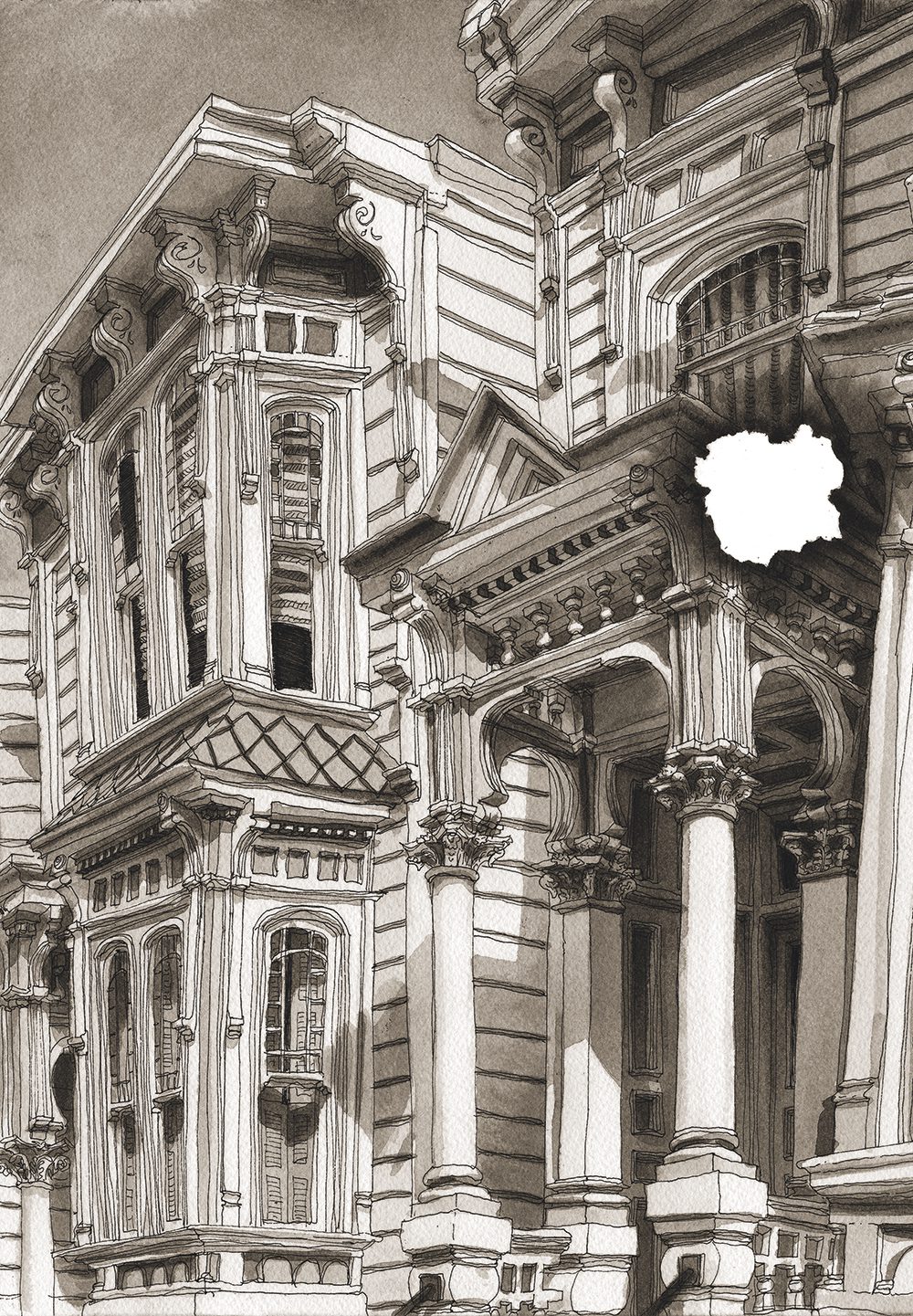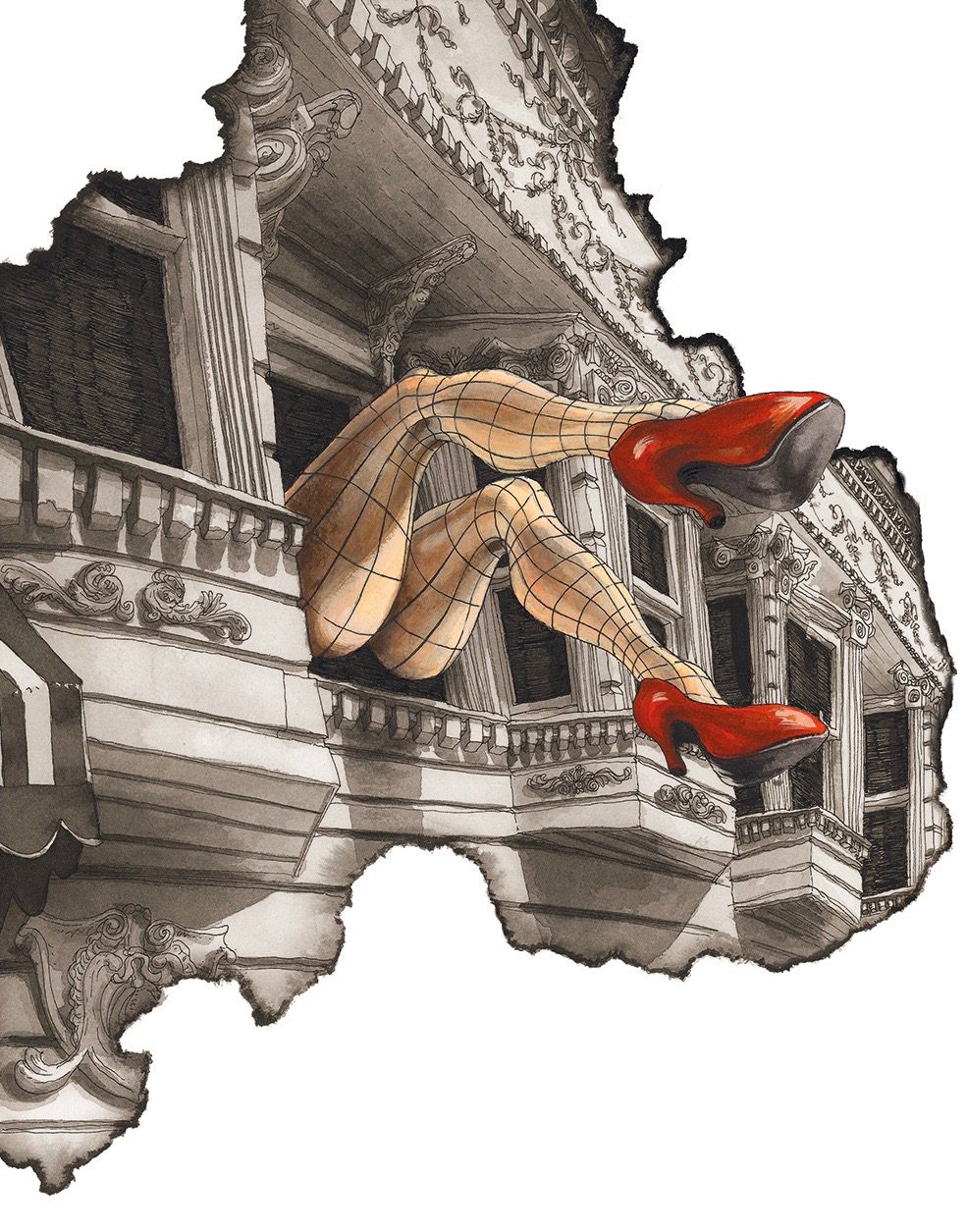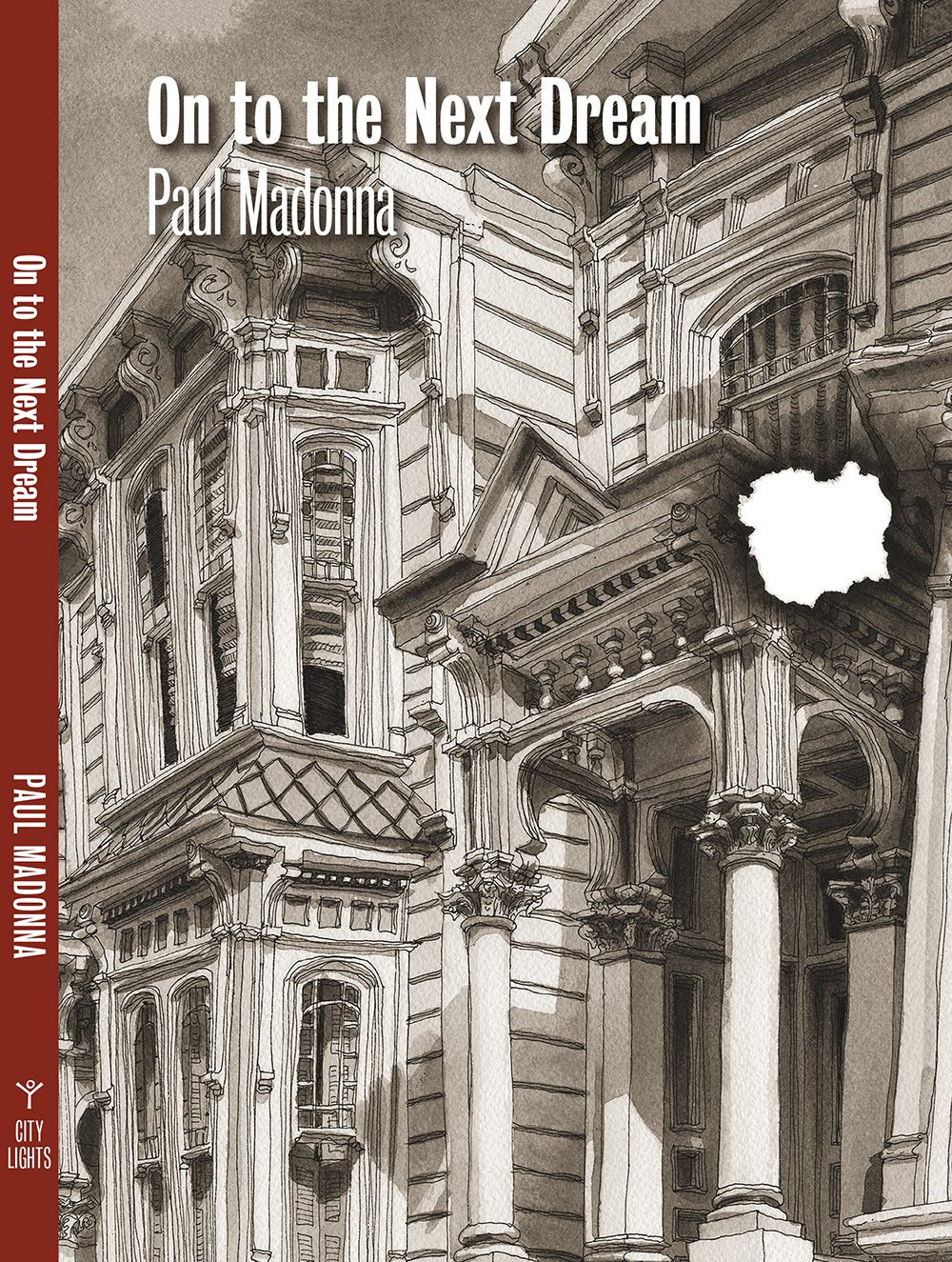Paul Madonna was the founding editor of the Rumpus Comics section. We are excited to offer a preview of artwork from his new book, On to the Next Dream, alongside an interview with our current Comics Editor, Brandon Hicks, and an exclusive excerpt.
This Saturday, April 1st, join Paul Madonna for a book launch celebration at 3 Fish Studios, 4541 Irving Street, San Francisco. Paul will be signing books from 5 p.m.–7 p.m., with a party to follow from 7 p.m.–9 p.m.
***
The Rumpus: This book spawned from an experience a couple of years ago, when you were suddenly evicted from your home and studio of ten years. Can you explain your decision to approach this subject in such a direct way?
Paul Madonna: What I am most proud of with this book is how I turned an intensely emotional experience into art. Anyone can run up to a rooftop, tear off their clothes, and scream about how screwed up the world is. But for the people down below, all they see is a person losing their mind. I wanted to make something that channeled that emotion in a way that elicited an empathetic response from the reader. So that after you read this book, you would want to run up to the rooftop and scream about how screwed up the world is.
This is why the story is so outlandish. I call it absurdist fiction, because the story is utter hyperbole. The story builds to such an exaggerated and ridiculous pitch that there’s no way it can be true—and yet, because it’s based on the current cultural climate, it feels as if it is. There’s a scene in an apartment where a real estate agent is standing on the counter auctioning the place off, and we realize it’s not the apartment she’s selling, but a cardboard box in the corner. When I wrote that I thought it was hilarious, and obviously absurd, but after it ran in the San Francisco Chronicle, people wrote to me asking if it was actually true. I couldn’t believe anyone might think that. But it showed me how accustom we’ve become to living with absurdity, and that to make people to see how much so, I had to ratchet up the insanity.
In turn, this approach helped me to deal head-on with the anxieties of the situation. It forced me to be not just aware of my thoughts, feelings, and reactions, but to also to address them critically. If I was feeling angry, I had to investigate not just who or what I was angry at, but why. And then I had to do the hard part and ask myself: Are you justified in where your anger is being directed? So, while I allowed my emotions to be valid, I knew that if I were to use them constructively, in the service of art, then I had to look at them dispassionately. Some might call this therapy, and I suppose it was. But I also had a goal that was larger than just healing myself, which was connecting to an audience.
Rumpus: Was this conceived as a long-term series with a beginning, middle, and end, or did you take it week by week until you were satisfied that the work was finished?
Madonna: When I wrote what eventually became the first chapter, where the character of me is at a café getting accosted by a middle-aged woman who mistakes me for a tech person, I had thought I was writing just a regular one-off All Over Coffee strip. Then after it ran in the Chronicle I received so many emails saying that I’d captured the anxious spirit of the city, that I saw how it could be the perfect launch pad for a longer story. After that everything fell quickly into place. I understood that I was now writing the final story of All Over Coffee, and began to plot each installment similar to outlining a novel.
The result was that the story, and this book, became about much more than me facing a challenging situation; it became about how all of us feel when we’re thrust unexpectedly into change. It’s about how we all hold onto personalized visions of our lives, our city, and our culture, and what we do when reality forces us to confront the impermanence of those visions.
Rumpus: Although this work does remain somewhat consistent in its format to your other All Over Coffee work, the presentation in this book, with the images preceding pages of typeset text, seems to read more like illustrated stories, rather than a comic strip. Do you think this has an impact on how the reader absorbs the work? Does this distinction matter to you?
Madonna: It matters a great deal to me. I want people to engage with this book as a story first, images second. This is why the book as an object is small, the paper is soft, and the story is typeset rather than handwritten. For fans of All Over Coffee, they’ll see this in comparison to my previous books, but for new readers, they’ll take it very much on face value, as a story. And I like both of those points of view.
Rumpus: Location has always been central to your work. This may seem a little on the nose to point out, but the illustrations in this book give less of a sense of place, and rather, create more a sense of displacement. To me, these drawings provide greater sense of movement than your earlier strips. Traditionally, your art has created a more contemplative stillness. The line in these drawings tends to bend, wobble, and curve more. In short, they feel more alive. How do you think this experience has changed how you look at your setting with an eye to reproduce it?
Madonna: This is a great observation, and I think you are correct that the drawings resonate differently. This is because their role was different. Previously in All Over Coffee, the image and the text existed as two equal, but separate and often disparate, elements that were paired to create a third reaction. But here, the story led every decision. I had a plot to unfold, and so everything had to be in service to that. It meant that I needed a theme for the drawings. At first this became objects that had I found abandoned on the street, but then I began building on that, like with the robot drawing. Then about halfway through writing the story I came up with the ‘burn’ theme, and that’s when I knew I had the visual crux of my story. One that echoed the overall theme of loss and change. From there I began introducing burns into the drawings, and eventually let that theme take over, until there was nothing on the page but the burn. It was quite cathartic, actually, to disintegrate my own style.
Rumpus: I’d like to talk about your use of color and burn marks in the work. Color changes the entire dynamic of the image, especially when used as have here, highlighting certain props and objects. The burning obviously has a metaphorical implication relating to the text, but it also gives the more immediate impression of an outside influence effecting the world that you’ve created. Can you explain your decision to use these tools for these stories?
Additionally, you’ve called this a work of absurdist fiction. Reading the work, a couple names come to mind, including Barthelme, Sartre, and even Kafka to a certain extent. Absurdist literature, almost by definition, cannot come from one influence or structure, but this does seem to fit in nicely with the tradition of absurdist literature. What compelled you to tell this story in this way?
Madonna: I’m a believer that form follows function. I wrote a handful of pieces that I ultimately discarded before I hit on the style I used for this book. As I said above, the chapter in the café came accidentally. And once I saw its power and potential, everything snapped into place. I’m a huge Barthelme fan, and have actually written several pieces inspired by his style (e.g. here and here). And while I’m also a fan of Kafka, way too much is called Kafka-esque these days, so I hesitate to trot him out as a source. When writing, I was thinking of Ionesco and Beckett, but their approach was too abstract for the topic, so the most influential author was Etgar Keret. I’ve been a fan of his stories for years, and it’s his point of view that showed me how potent the absurd form can be. This is not new information. We see this right now with regard to the political climate. SNL is the best it’s been in years, because there’s a real-world situation that has risen to meet their platform of satire.
Rumpus: I think it’s fair to say that this collection is pretty pointed. You have a statement to make. Rather than simply reporting on what had happened to you (and what is happening to many other people), as an artist you approached it from a more emotional, abstract angle. What do you think is the value of thinking creatively about the issues we face as a society? Do you think artists have a significant role to play in times like present, when all eyes are suddenly focused on Washington?
Madonna: Yes, absolutely. I’ve been thinking about this a lot lately. Building on what I was saying above, about this book being emotion turned into art, I think the more chaotic the times, the more the role of creatives becomes crystalized. Our job is to translate the lies, deceit, and anxiety that poisons our cultural water supply into an understandable form that we can digest. Most of us have heard the analogy of artists being like canaries in the coal mine, but I think there’s a new twist on that, which is not that we the artist canaries collapse first, alerting everyone else that the air is toxic, but that we start squawking our heads off, which tells everyone that the air isn’t safe to breathe.
***
Exclusive excerpt from On to the Next Dream:
There was a line out the door but I managed to squeeze inside. “Asking price is one million,” I heard the real estate agent call out. She was standing on the kitchen counter, strapped into a square-shouldered business suit, scanning the crowd with eyes like an airport x-ray machine.
“But of course it will go for hundreds of thousands more,” a man said, pushing me aside with a baby stroller.
“Obviously,” said the agent. “A million is just how much it takes for me to treat you like you actually exist.”
“Well then here I am,” the man said, throwing his arms wide then gesturing grandly to the stroller as if he were presenting a newborn king. That’s when I saw that the carriage was filled not with a baby, but with bundles of crisp hundred-dollar bills.
Cupping my hands to my mouth I asked, “How many bedrooms?” And when a shrill “Ha!” erupted from across the room I turned to see a bird-legged woman in a baseball cap and extra-tight workout clothes shaking her head at me.
“It’s not the apartment that’s for sale,” she said, as if I were a potted plant that had miraculously learned to speak. “We’re here to bid on that—” and like a Suburban Samurai brandishing her sword, she whipped a yoga mat from over her shoulder and pointed to a cardboard box in the corner.
Instantly the stroller guy darted over and hopped inside the box. “It’s perfect!” he squealed, squatting down like a fat housecat squeezing into a coffee cup. “And now it’s all mine, mine, mine!”
***
All images © Paul Madonna. Images and excerpt reprinted from On to the Next Dream © Paul Madonna 2017, available now from City Lights Publishers. Excerpt and images reprinted with permission.
